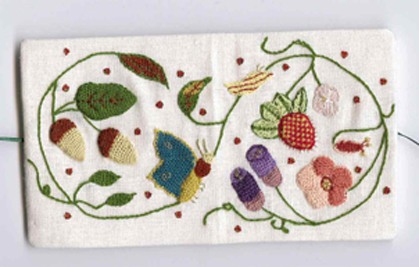Surface Embroidery
Whether you are doing a simple running stitch or a more complicated bit on a piece of cloth, you are following a centuries old tradition of embroidery. Decoration on cloth with thread has been around nearly as long as we have had cloth clothing.
One of the key questions that is asked is "what stitch was used when?". The answer is not a simple one as the key is in the context - both in terms of country/location/culture and style. Perhaps the main question was how was the stitch used. Thus, if you are trying to follow a design from a certain era it is important to do a bit of research as to what would have been done as well as what thread type would have been used.
Having said that here is a quick listing of what is commonly referred to as basic surface embroidery stitches and a bit on basic context for historical (pre-1600) embroidery. For HOW to do these stitches there are a number of good stitch guides out -- look at Sharon B's and ANG for a couple that have explanations that I like.
| Chain Stitch |
Coptic/Mediteranean - BCE and through 1000 - wool on linen, used as a filling stitch
Viking - Scandinavia 10th C - silk on silk as both outline and filling |
| Split Stitch |
Opus Anglicanum - 12th C - 14th C. Europe - silk on linen filling and fine shading |
| Long and Short Stitch |
Opus Anglicanum - 12th C - 14th C. Europe - silk on linen filling and fine shading |
| Outline/Stem Stitch |
Mammen - Scandinavia 10th C - wool on wool, used to outline and fill
Viking - Scandinavia 10th C - wool on wool, silk on silk, gold on silk, for usually outlines with some filling
Tudor/Elizabethan - outlines for Blackwork filling patterns, various nature motifs, and strapwork |
| Couching |
Viking - Scandinavia - 9th/10th C. - wool on wool, wool on linen |
| Herringbone & Van Dyke variant |
Viking - Scandinavia - 7-10th C - interlaced/plaited stitches over seam - wool on wool, wool on linen, silk on silk |
| Bayeux Stitch |
Norman - 11th C - wool on linen as filling with outline stitch |
| Running Stitch/Speckling |
Late Elizabethan - used in blackwork as a shading type of filling - silk on linen or silk |
| Buttonhole Stitch |
16th C Europe - used as a lace stitch and on clothing as an edging on button holes (14th -16th C) - linen for lace and silk for clothing |
| Detached Buttonhole |
Late Elizabethan - used as a filling stitch - silk on linen or silk or velvet (with metal threads) |
Sometimes when I am teaching concepts of interlace and filling patterns I use this handout that walks throught outline, chain, and split stitches.
 Later Elizabethan embroidery was raised embroidery - where the stitches were raised by various means (stuffing, thread padding, felt or board padding) off of the basic fabric. This is my teaching piece.
Later Elizabethan embroidery was raised embroidery - where the stitches were raised by various means (stuffing, thread padding, felt or board padding) off of the basic fabric. This is my teaching piece.
Detached buttonhole is easy once you understand the concepts behind it. Historically you get 3 variations - going right to left and the reverse, going to the right with a return thread, and a lace variation where you skip stitches.
There are 3 main detached stitches in Elizabethan embroidery - detached buttonhole, trellis stitch and hollie point. Each creates its own form of texture which was important to help emphasize the designs.
 Later Elizabethan embroidery was raised embroidery - where the stitches were raised by various means (stuffing, thread padding, felt or board padding) off of the basic fabric. This is my teaching piece.
Later Elizabethan embroidery was raised embroidery - where the stitches were raised by various means (stuffing, thread padding, felt or board padding) off of the basic fabric. This is my teaching piece.